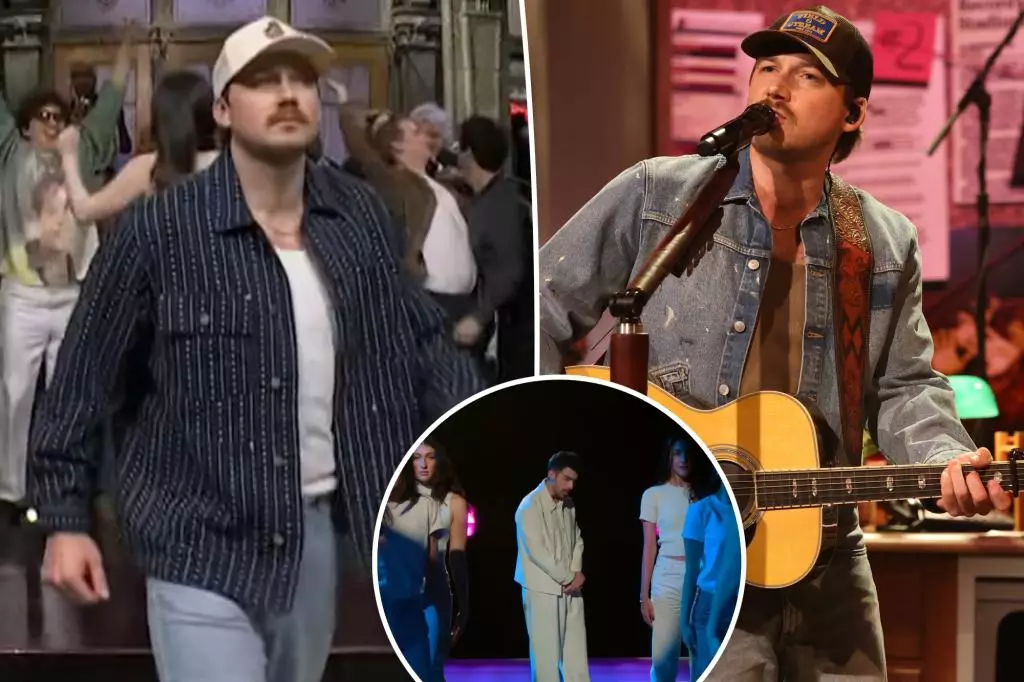The recent episode of “Saturday Night Live” (SNL) took a surprising turn when country star Morgan Wallen declined to participate in a comedic sketch, prompting none other than Joe Jonas to fill in at the last moment. This development not only shifted the spotlight from Wallen to Jonas but also raised questions about celebrity collaborations and the backstage atmosphere of live television. What might have seemed like a simple scheduling conflict has unveiled the complexities of artist interactions, expectations, and potential off-stage tensions.
Sources informed Page Six that Wallen wasn’t overly congenial during his appearance. He performed his musical set but opted out of participating in a pre-taped sketch, a common practice for musical guests involved in SNL. Instead, he left the studio abruptly, a move that many found curious and somewhat disrespectful given the show’s collaborative spirit. For a platform built on its ensemble nature, Wallen’s decision to distance himself from sketch involvement brought an awkward energy to the episode.
The Impact of Celebrity Behavior
The incident not only highlights the unpredictable aspects of celebrity behavior but also opens up a broader discussion on the expectations placed on artists in collaborative environments. SNL is renowned for the dynamic between its musical guests and cast members, with playful banter often enhancing the performance. By stepping back, Wallen may have unintentionally isolated himself from forming valuable connections within the industry. While it’s certainly his prerogative to choose how he engages, maintaining rapport with fellow performers is crucial in an industry that thrives on collaboration.
The sketch in question featured cast regulars like Ego Nwodim and Bowen Yang, who illustrated the humor in New York City’s incessant waiting lines, accompanied by spirited lyrics sung by Jonas that infused encouragement in the context of mundane inconveniences. Jonas’s participation—offering quips about yogurt and wine—embodies the essence of SNL, where the blending of entertainment and commentary is masterfully executed. Wallen missing this opportunity to join the fun left a gap, one that highlighted a possible misalignment between artist expectations and production culture.
Public and Media Perception
After the show aired, social media buzzed with speculation. Fans and critics alike began to dissect Wallen’s actions, from his abrupt departure during the closing credits to the fact that he seemingly skipped a post-show celebration. Some suggested that there might have been “beef” between Wallen and the cast—an assumption that tends to snowball in the online landscape. Yet, sources attempted to quell the rumors by stating that Wallen’s hasty exit was habitual and not a reflection of any underlying issues. The dilemma lies in how public narratives often morph into sensationalized stories, obscuring the truth and complicating an artist’s public image.
The fact that SNL’s creators remain optimistic about Wallen’s return as a musical guest suggests an understanding of the pressures faced by artists balancing their private lives and public personas. The forgiveness shown by the SNL team reflects the industry’s forgiving nature, at least on the surface. However, it raises critical questions about accountability and the responsibilities that come with celebrity status.
Reflections on the Nature of Collaboration
In an age where social media amplifies every moment, the lessons from Wallen’s SNL appearance are multifaceted. For artists, the necessity of engagement—be it backstage camaraderie or onstage chemistry—remains paramount. The dynamic nature of live performance presents unique pressures; thus, the importance of navigating those moments gracefully cannot be overstated. These situations remind us that success is rarely achieved in solitude; rather, it flourishes in the nexus of talent, collaboration, and mutual respect.
As fans and artists process incidents like Wallen’s, there’s a fine line between interpretation and judgment. Understanding the stresses of live performance and the role of personal preference in collaboration can foster a more empathetic viewpoint within the fan community. Ultimately, how artists respond to such events shapes not only their lasting impressions but also the evolving landscape of performance art itself. The incident serves as a reminder that entertainment is often as much about the journey as it is about the destination, weaving stories that transcend mere moments on screen, compelling audiences to reflect on the humanity behind the celebrity façade.

